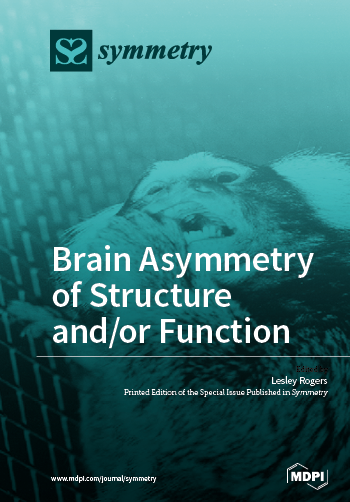Brain Asymmetry of Structure and/or Function
A special issue of Symmetry (ISSN 2073-8994).
Deadline for manuscript submissions: closed (15 July 2017) | Viewed by 76435
Special Issue Editor
Interests: lateralization of brain and behaviour in vertebrates and invertebrates; development of lateralization; evolution of lateralization; function of brain asymmetry; communication in birds and primates
Special Issues, Collections and Topics in MDPI journals
Special Issue Information
Dear Colleagues,
Left–right asymmetry is an important characteristic of the brain, as we now know from studies of many vertebrate species and, more recently, from studies of invertebrates. The commonality of this feature of the brain suggests that it affords all, or many, brains advantages in cognitive processing by, for example, allowing parallel and different processing of inputs on each side of the brain and by each side controlling different sets of outputs.
In some species, asymmetry of brain structure is clearly evident, as long known to be the case in humans, whereas, in other species, structural asymmetries are less obvious or not, as of yet, known to be present even though behavioural asymmetries are observable.
Research on asymmetry in a broad range of species, including humans, will be considered for this Special Issue and the focus of contributions may be on behavioural lateralization, asymmetries in anatomy or neural organisation, role of genes, hormones and environmental factors in the expression of lateralization and the likely advantages or disadvantages of having brain asymmetry. Furthermore, papers on factors influencing the development of brain asymmetry will be particularly relevant, and so will papers on the evolution of brain asymmetry. Reports of research findings on brain asymmetry, reviews and theoretical discussions of the role of asymmetry will be acceptable contributions.
Prof. Lesley J. Rogers
Guest Editor
Manuscript Submission Information
Manuscripts should be submitted online at www.mdpi.com by registering and logging in to this website. Once you are registered, click here to go to the submission form. Manuscripts can be submitted until the deadline. All submissions that pass pre-check are peer-reviewed. Accepted papers will be published continuously in the journal (as soon as accepted) and will be listed together on the special issue website. Research articles, review articles as well as short communications are invited. For planned papers, a title and short abstract (about 100 words) can be sent to the Editorial Office for announcement on this website.
Submitted manuscripts should not have been published previously, nor be under consideration for publication elsewhere (except conference proceedings papers). All manuscripts are thoroughly refereed through a single-blind peer-review process. A guide for authors and other relevant information for submission of manuscripts is available on the Instructions for Authors page. Symmetry is an international peer-reviewed open access monthly journal published by MDPI.
Please visit the Instructions for Authors page before submitting a manuscript. The Article Processing Charge (APC) for publication in this open access journal is 2400 CHF (Swiss Francs). Submitted papers should be well formatted and use good English. Authors may use MDPI's English editing service prior to publication or during author revisions.
Keywords
- functional brain asymmetry
- structural brain asymmetry
- gene expression
- environmental influences
- hormonal influences
- development
- advantages
- disadvantages
- evolution






